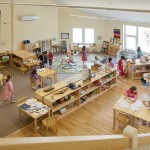I swore I would never teach junior high. Junior high, two swirling years of what, as a student, I experienced as daily hell. I owe all my patient and forgiving junior high teachers a debt of gratitude.
By the time I was a teacher, though, the middle school model prevailed. It was a three year plan, and many schools formed teams and innovated around the idea of supporting students developmentally through these perilous years of pubescence.
So I swore I wouldn’t teach middle school.
Well, here I am in junior high, and enjoying the challenge.
Yup. Junior high. Two years.
At the school where I teach, some of the veteran teachers of the district make fleeting references to “the year they took away our ninth graders” to explain the sometimes-perceived lack of leadership or drive among students. They remember when the 8th graders weren’t so full of themselves, and how the 9th grade students’ involvement with the high school sports teams helped them make the transition and showed students what came next. They don’t think two years is long enough.
I teach English Language Learners, and two years is not enough to serve my students well. The most difficult conundrum is trying to serve students who may have learning disabilities along with the need to learn English. Some students have dual-labeled Special Education and English Language Learner. Teams of teachers and other staff need thoughtful discussions to decide on the best placement for them in this new world of switching classes, and homework from seven teachers. For a myriad of systemic reasons, these conversations rarely begin until well into first semester, which is 25% of their junior high experience. There is little time to intervene.
In addition, I am noticing that some of my ELL’s probably need evaluation for special education services. For example, if a Spanish speaking student has been in English Language coursework for 2-4 hours a day since 2nd grade, and I am getting them as a 7th grader, and they are still really low in English, to me that sends up a red flag that maybe they experience other learning challenges. However, the process to evaluate a student for possible special education services is intricate and can take an entire school year, if not more. How on earth will I know these students quickly enough to make sure they have what they need before they head to high school? Two years is not enough time for our less than nimble system.
However, two years is a long time in the education of a child. A child who goes for a year without proper placement suffers gaps that are difficult to overcome.
The Arizona state legislature just passed SB1042. It is likely to be signed today. The new law shreds the foundation of teacher certification requirements by having the state board of education immediately expand and loosen its requirements of approved alternative teacher preparation programs, among other things. For grades 6-12, a science/math/engineering/tech teacher doesn’t even have to pass a professional knowledge test anymore.
The idea is that we can address Arizona’s teacher shortage by getting more people in the classroom quickly. But this doesn’t address the real problem, which is putting into the classroom teachers who understand such topics as child development, language acquisition and disability.
Imagine a junior high where three or four out of your child’s seven teachers each day have no training in any of these areas, and no experience teaching 12- and 13-year-olds. Imagine that your family just moved here from Syria, Senegal or Chihuahua, and you trust that at school, your child will learn English (and math, and science, and health, and…) Or, imagine that you have lived here your whole life, but your child is a shy, sensitive introvert. Or dyslexic. Or the class clown. Or depressed. Or just impulsive. It’s not hard to imagine how throwing teachers into a classroom unprepared is a bad idea, no matter how much they know about other topics.
Two years is not enough. But even without SB1042, we have already slid down the slippery slope of teacher certification. Close to half of positions are filled with folks in alternative certification programs or long-term subs. And to be perfectly honest, we are lucky to have them. They care about kids, and are working hard, and those in teacher preparation programs are often juggling being a new teacher with college coursework for two years. The ones I see are committed to the profession, no matter how they got here. And yet everyone has a first two years.
What if the majority of your child’s classrooms were filled with first- or second- year teachers, many of whom will have little to no professional training? We are almost already there.
The irony? There are literally thousands of highly qualified, certified, and experienced Arizona teachers out there who could fill those jobs. If only they could make a living at it.










Comments 3
Thank you! SB1042 is bad for kids…that’s the bottom line. Maybe it will (on the surface) help with teacher-recruitment problem, but it will exacerbate the teacher-retention problem, creating more churn for our students. They (legislature and governor) need to work on actually solving the problem, not sticking a bandaid on it. Plus the “bandaid” is one of those off-brand kinds that comes off the wound the second it hits water.
I can’t help but think that most of the folks who write and push these bills understand they are bad for kids. But the kids are not their priority or motivation, it seems.
You are so right- there are plenty of certified, capable teachers out there who QUIT and refuse to come back because the working conditions are so wretched. We need to get them back!